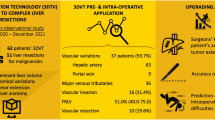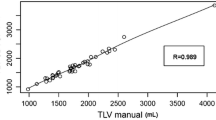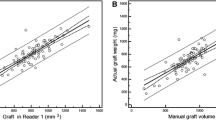Abstract
Objectives
3D reconstructions of CT data permit precise planning of liver surgery. To analyze the realisation of surgical plans 3D reconstructed postoperative CT data were evaluated.
Method
Pre- and postoperative CT data were analyzed on a series of 15 liver resections (2 hemihepatectomies and 13 segmental resections) by 3D reconstruction of portal and hepatic veins. Virtual surgical resection plans were compared with 3D reconstructed postoperative CT data and clinical data.
Results
Pre- and postoperative CT data as the basis for subsequent processing were of comparable quality. Detailed elaboration of data could be realized with an overall data processing and analyzation time of 120 min. The best correlation between calculated and actually measured liver resection volume was obtained by intersection volumes of portal and hepatic veins (k = 0.828, P < 0.000). However, portal and hepatic vein analysis revealed 9 and 12% of liver parenchyma with unplanned resection and 5 and 1% of unplanned residual tissue. No correlation with clinical data was found in this series.
Conclusion
Volume calculation without consideration of vascular anatomy is less suited for precise assessment of surgical plan implementation in our study. Comparison of pre- and postoperative vascular structures with the aid of three-dimensionally reconstructed CT data is feasible. Unplanned resected and remained liver tissue can be identified. However, its clinical meaning for quantitative analysis of surgical plan implementation is questionable and should be investigated in larger series.
Similar content being viewed by others
References
Foster JH (1970) Survival after liver resection for cancer. Cancer 26(3):493–502. doi:10.1002/1097-0142(197009)26:3<493::AID-CNCR2820260302>3.0.CO;2-7
Junginger T (2007) Liver surgery. Zentralbl Chir 132(4): 265–266. doi:10.1055/s-2007-981252
Romano F, Franciosi C, Caprotti R et al (2005) Hepatic surgery using the Ligasure vessel sealing system. World J Surg 29(1): 110–112. doi:10.1007/s00268-004-7541-y
Felekouras E, Prassas E, Kontos M et al (2006) Liver tissue dissection: ultrasonic or RFA energy?. World J Surg 30(12): 2210–2216. doi:10.1007/s00268-005-0468-0
Schemmer P, Friess H, Hinz U et al (2006) Stapler hepatectomy is a safe dissection technique: analysis of 300 patients. World J Surg 30(3): 419–430. doi:10.1007/s00268-005-0192-9
Jonas S, Thelen A, Benckert C et al (2007) Extended resections of liver metastases from colorectal cancer. World J Surg 31(3): 511–521. doi:10.1007/s00268-006-0140-3
Virani S, Michaelson JS, Hutter MM et al (2007) Morbidity and mortality after liver resection: results of the patient safety in surgery study. J Am Coll Surg 204(6): 1284–1292. doi:10.1016/j.jamcollsurg.2007.02.067
Yamanaka J, Saito S, Fujimoto J (2007) Impact of preoperative planning using virtual segmental volumetry on liver resection for hepatocellular carcinoma. World J Surg 31(6): 1249–1255. doi:10.1007/s00268-007-9020-8
Grenacher L, Thorn M, Knaebel HP et al (2005) The role of 3-D imaging and computer-based postprocessing for surgery of the liver and pancreas. Rofo 177(9): 1219–1226
Reitinger B, Bornik A, Beichel R et al (2006) Liver surgery planning using virtual reality. IEEE Comput Graph Appl 26(6): 36–47. doi:10.1109/MCG.2006.131
Fazakas J, Mandli T, Ther G et al (2006) Evaluation of liver function for hepatic resection. Transplant Proc 38(3): 798–800. doi:10.1016/j.transproceed.2006.01.048
Torzilli G, Del FD, Palmisano A et al (2007) Contrast-enhanced intraoperative ultrasonography: a valuable and not any more monocentric diagnostic technique performed in different ways. Ann Surg 245(1): 152–153. doi:10.1097/01.sla.0000250940.21627.57
Beller S, Hünerbein M, Lange T et al (2007) Image-guided surgery of liver metastases by 3D ultrasound based optoelectronic navigation. Br J Surg 94(7): 866–875. doi:10.1002/bjs.5712
Lamecker H, Seebass M, Lange T et al (2004) Visualization of the variability of 3D statistical shape models by animation. Stud Health Technol Inform 98: 190–196
Selle D, Preim B, Schenk A et al (2002) Analysis of vasculature for liver surgical planning. IEEE Trans Med Imaging 21(11): 1344–1357. doi:10.1109/TMI.2002.801166
Hamady ZZ, Cameron IC, Wyatt J et al (2006) Resection margin in patients undergoing hepatectomy for colorectal liver metastasis: a critical appraisal of the 1 cm rule. Eur J Surg Oncol 32(5): 557–563. doi:10.1016/j.ejso.2006.02.001
Pawlik TM, Scoggins CR, Zorzi D et al (2005) Effect of surgical margin status on survival and site of recurrence after hepatic resection for colorectal metastases. Ann Surg 241(5): 715–722. doi:10.1097/01.sla.0000160703.75808.7d
Shirabe K, Takenaka K, Gion T et al (1997) Analysis of prognostic risk factors in hepatic resection for metastatic colorectal carcinoma with special reference to the surgical margin. Br J Surg 84(8): 1077–1080. doi:10.1002/bjs.1800840810
Wray CJ, Lowy AM, Mathews JB et al (2005) The significance and clinical factors associated with a subcentimeter resection of colorectal liver metastases. Ann Surg Oncol 12(5): 374–380. doi:10.1245/ASO.2005.06.038
Yamamoto J, Shimada K, Kosuge T et al (1999) Factors influencing survival of patients undergoing hepatectomy for colorectal metastases. Br J Surg 86(3): 332–337. doi:10.1046/j.1365-2168.1999.01030.x
Lang H, Radtke A, Hindennach M et al (2005) Impact of virtual tumor resection and computer-assisted risk analysis on operation planning and intraoperative strategy in major hepatic resection. Arch Surg 140(7): 629–638. doi:10.1001/archsurg.140.7.629
Beller S, Hünerbein M, Eulenstein S, et al (2007) Feasibility of navigated resection of liver tumors using multiplanar visualization of intreaoperative 3D ultrasound data. Ann Surg 246:D-06-00505 (in press)
Konopke R, Bunk A, Kersting S (2007) The role of contrast-enhanced ultrasound for focal liver lesion detection: an overview. Ultrasound Med Biol
Wigmore SJ, Redhead DN, Yan XJ et al (2001) Virtual hepatic resection using three-dimensional reconstruction of helical computed tomography angioportograms. Ann Surg 233(2): 221–226. doi:10.1097/00000658-200102000-00011
Schindl MJ, Redhead DN, Fearon KC et al (2005) The value of residual liver volume as a predictor of hepatic dysfunction and infection after major liver resection. Gut 54(2): 289–296. doi:10.1136/gut.2004.046524
Dello SA, van Dam RM, Slangen JJ et al (2007) Liver volumetry plug and play: do it yourself with ImageJ. World J Surg 31(11): 2215–2221. doi:10.1007/s00268-007-9197-x
Kobayashi T, Imamura H, Aoki T et al (2006) Morphological regeneration and hepatic functional mass after right hemihepatectomy. Dig Surg 23(1–2): 44–50. doi:10.1159/000093754
Lemke AJ, Brinkmann MJ, Schott T et al (2006) Living donor right liver lobes: preoperative CT volumetric measurement for calculation of intraoperative weight and volume. Radiology 240(3): 736–742. doi:10.1148/radiol.2403042062
Fujimoto J, Yamanaka J (2006) Liver resection and transplantation using a novel 3D hepatectomy simulation system. Adv Med Sci 51: 7–14
Author information
Authors and Affiliations
Corresponding author
Rights and permissions
About this article
Cite this article
Beller, S., Lange, T., Eulenstein, S. et al. 3D-Elaboration of postoperative CT data after liver resection: technique and utility. Int J CARS 3, 581–589 (2008). https://doi.org/10.1007/s11548-008-0262-1
Received:
Accepted:
Published:
Issue Date:
DOI: https://doi.org/10.1007/s11548-008-0262-1




